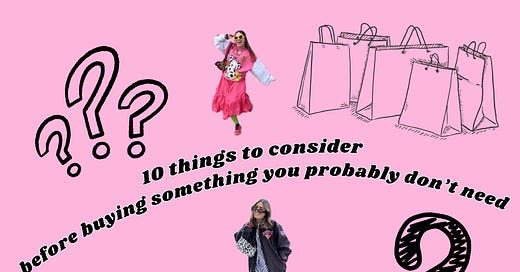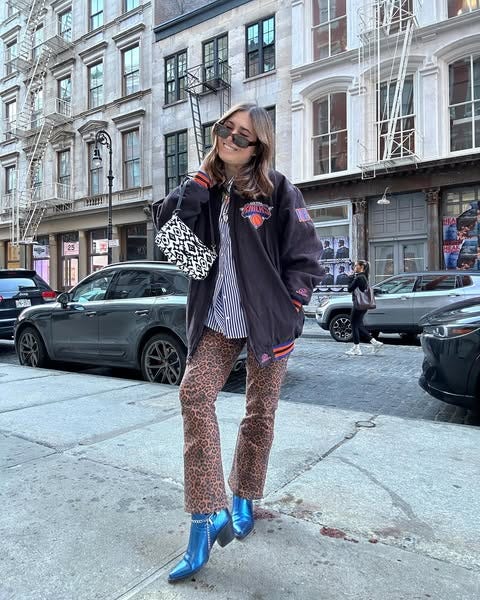10 things to consider before buying something you probably don't need
Build a more sustainable and curated closet with these 10 questions.
After shopping mindlessly for many years, I’ve been on a multi-year journey to be more intentional about what I add to my overflowing closet.
To be more selective with what I buy, I’ve come up with 10 questions to ask myself before I hit “Purchase.” These questions have helped me cut down some of my unnecessary spending and saved me from the heartache of ending up with a bunch of nice items that aren’t quite right.
This is part 1 of a 2-part series. In part 2, I’ll be talking about the best 10 items I’ve ever shelled out a lot of money for (because I followed these questions :) ),
So with that, let’s get into it!!!
1. Can I wear it to work?
Hate that I have to ask myself this lol but it’s so real. Now that I spend most of my time in an office, if I can’t wear it to work, it probably won’t see much wear, period. So this is the number one question I ask myself these days.
So long as it’s modest enough and doesn’t contain any vulgar words or imagery, you can pretty much wear anything to most office jobs, if you style it creatively.
2. Can I envision at least 5 outfits or occasions where I’d want to wear this?
This is a tip that
gave me and it’s such a good one. It’s saved me from accumulating too much resortwear (because realistically, how many resort vacations am I really going on per year?!?).My black and white coat from The Ragged Priest matches most of my winter wardrobe.
3. Do I already have anything similar?
When we shop, we tend to gravitate towards things we like, and sometimes, that means gravitating towards stuff we already own. For example, I tend to gravitate towards denim jackets at vintage fairs. But as someone who already has 2, I use this question to remind myself not to spend money on jackets.
4. Have I seen other versions of this item or is it totally unique?
This comes into play when examining the cut, the print, and the silhouette—if you’ve never seen ANYTHING remotely close in resemblance to the item you’re eyeing, that’s a strong sign that it’s a unique find. You can always do a reverse Google image search to confirm there’s nothing similar floating around if you’re not sure.
My A. Potts skirt that’s a true sample—no others were made.
5. Can I find it secondhand?
Most basics (plain blouses, jeans, classic jackets and blazers, Chelsea boots, etc.) can be found secondhand fairly easily (for straight-sized folks). For more unique firsthand items that won’t be on the secondhand market *just yet,* the question then becomes: can I wait until this becomes more available on secondhand shopping sites (which ties into question 10)?
To give you another example, I REALLY wanted the Damson Madder leopard pants when they came out. I mean, talk about a trendy item. They were ALL over my IG feed last year, I couldn’t escape. I love leopard and always have, so it’s not that I wouldn’t wear them enough if I bought them firsthand, but I ultimately decided to buy a different pair of leopard pants on Poshmark to get a similar look for less. I saved money, shopped sustainably, AND I don’t look exactly like everyone else on my feed when I style mine.
My secondhand leopard jeans in action.
6. Is it classic or trendy? Do I envision myself getting tired of it?
It’s generally not a good idea to buy a trendy investment piece (even stringing those words together is so oxymoronic) IF you’re not sure if the trend is *for you.* But hey, if you know you love bubble hems and always will, even when the trend dies down, by all means, invest in an expensive bubble hem dress.
BUT, if you’re shelling out money on the expensive bubble hem dress, not fully knowing if you’re truly a bubble hem girlie, then that’s probably not the move.
An investment piece should be something that you won’t get sick of styling, regardless of what’s currently trending.
The metallic cowboy boot wall at Awoke Vintage. I own 2 pairs and I’ve never looked back.
7. Quality (material composition and stitching)
This tip right here changed my freaking life. Not exaggerating. Read the material tags on physical items or item details online and you will save so. much. money. Natural fibers (cotton, linen, wool, silk) are what you should be aiming for, from a quality and sustainability standpoint. Synthetic fibers (polyester, viscose, rayon, acyrilic) are more harmful to produce, don’t decompose fast enough, and don’t hold up as well over time.
You will be amazed? shocked? horrified? to see that so many brands are charging $200, $300, $400 for 100% polyester. No, thank you! Not worth it!!!
When you’re IRL shopping, look at the stitching closely. If the stitching is already coming loose when the item is still on the hanger, imagine how well (or not-so-well) it will fare in the wash?!?
8. Does it fit? Can I return it?
Whenever you’re shopping in store, PLEASE try things on!!! Save yourself the potential headache of a return and aim to try things on whenever you’re already there. You just truly never know.
For online purchases, though, make sure you read the return policy before buying. Some stores charge for return shipping, and other sites, like The RealReal, often have items that are final sale. Don’t buy an expensive item from a store with a not-so-great return policy unless you are 99.9% sure that it’s the right item for you.
It really sucks when bad policy is what stands between you and a dream item, but it’s just too risky, I’m sorry!!!!
9. Is the brand or retailer trustworthy?
This ties into the previous question. Especially with targeted ads, sometimes we get exposed to brands that seem like they’re almost too good to be true. But if you’re not familiar with a retailer, do some digging before you place an order. Look them up on social media, Reddit, and the Better Business Bureau to make sure they’re legit.
10. Can I afford to wait? Do I need this item right now?
I touched on this earlier, but it’s such an important one. If you’re not shopping for a specific occasion or season, then do you need this item right now? Or can you wait for a sale or until you find it secondhand or until the desire to shop goes away entirely???
Do you have any shopping guidelines or rules you follow? Could you see yourself following some or all of these? Let me know what you think! Becoming a conscious consumer takes time—I’m far from perfect, but I’m striving to be better.
︶⊹︶︶୨୧︶︶⊹︶︶⊹︶︶୨୧︶︶⊹︶︶⊹︶︶୨୧︶︶⊹︶︶⊹︶︶୨୧︶︶⊹︶
Thanks so much for reading (ノ◕ヮ◕)ノ*:・゚✧
See what I wear daily on IG
Catch up with past posts in the archive










